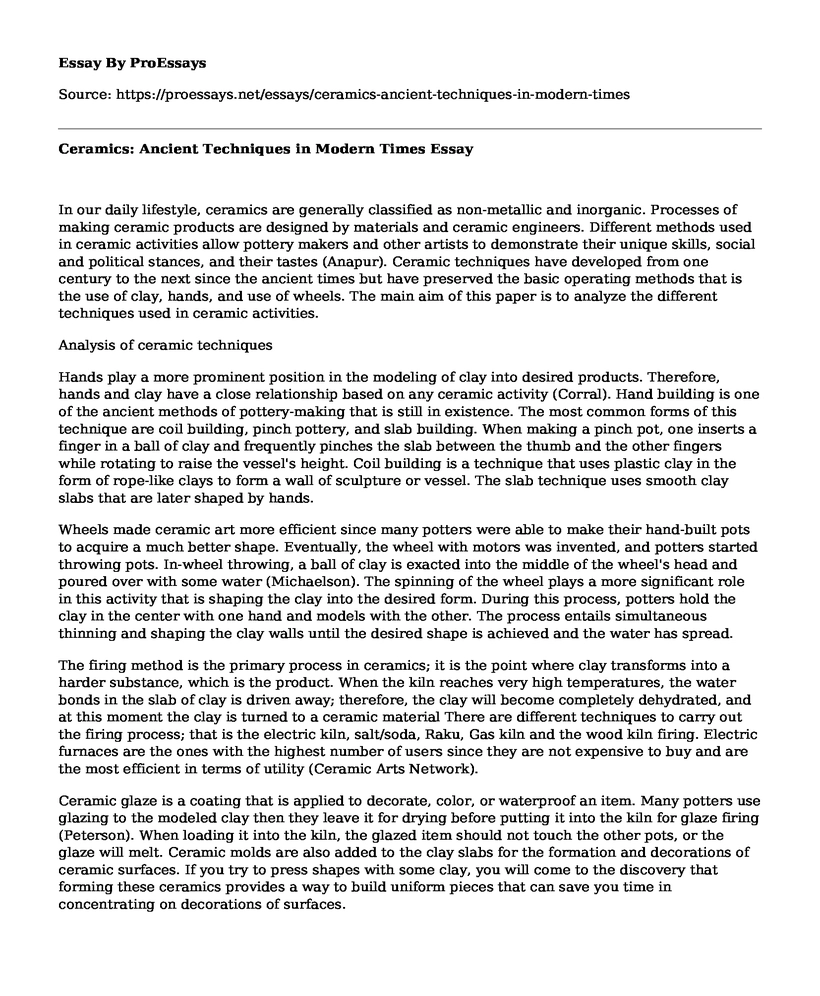In our daily lifestyle, ceramics are generally classified as non-metallic and inorganic. Processes of making ceramic products are designed by materials and ceramic engineers. Different methods used in ceramic activities allow pottery makers and other artists to demonstrate their unique skills, social and political stances, and their tastes (Anapur). Ceramic techniques have developed from one century to the next since the ancient times but have preserved the basic operating methods that is the use of clay, hands, and use of wheels. The main aim of this paper is to analyze the different techniques used in ceramic activities.
Analysis of ceramic techniques
Hands play a more prominent position in the modeling of clay into desired products. Therefore, hands and clay have a close relationship based on any ceramic activity (Corral). Hand building is one of the ancient methods of pottery-making that is still in existence. The most common forms of this technique are coil building, pinch pottery, and slab building. When making a pinch pot, one inserts a finger in a ball of clay and frequently pinches the slab between the thumb and the other fingers while rotating to raise the vessel's height. Coil building is a technique that uses plastic clay in the form of rope-like clays to form a wall of sculpture or vessel. The slab technique uses smooth clay slabs that are later shaped by hands.
Wheels made ceramic art more efficient since many potters were able to make their hand-built pots to acquire a much better shape. Eventually, the wheel with motors was invented, and potters started throwing pots. In-wheel throwing, a ball of clay is exacted into the middle of the wheel's head and poured over with some water (Michaelson). The spinning of the wheel plays a more significant role in this activity that is shaping the clay into the desired form. During this process, potters hold the clay in the center with one hand and models with the other. The process entails simultaneous thinning and shaping the clay walls until the desired shape is achieved and the water has spread.
The firing method is the primary process in ceramics; it is the point where clay transforms into a harder substance, which is the product. When the kiln reaches very high temperatures, the water bonds in the slab of clay is driven away; therefore, the clay will become completely dehydrated, and at this moment the clay is turned to a ceramic material There are different techniques to carry out the firing process; that is the electric kiln, salt/soda, Raku, Gas kiln and the wood kiln firing. Electric furnaces are the ones with the highest number of users since they are not expensive to buy and are the most efficient in terms of utility (Ceramic Arts Network).
Ceramic glaze is a coating that is applied to decorate, color, or waterproof an item. Many potters use glazing to the modeled clay then they leave it for drying before putting it into the kiln for glaze firing (Peterson). When loading it into the kiln, the glazed item should not touch the other pots, or the glaze will melt. Ceramic molds are also added to the clay slabs for the formation and decorations of ceramic surfaces. If you try to press shapes with some clay, you will come to the discovery that forming these ceramics provides a way to build uniform pieces that can save you time in concentrating on decorations of surfaces.
Conclusion
Indeed, the different techniques used in ceramics are thoroughly analyzed. It is clear that hands play a more prominent role in making ceramic materials; hands and clay have a close relationship in terms of pottery. The invention of the wheel with motors increased the efficiency of modeling clay to the desired ceramic objects. Firing is the dominant process in ceramics; the modelled clay is transformed into the desired materials. During heating, water bonds in the clay are driven out by high temperatures changing it entirely into a new substance. Ceramic glazing is applied to waterproof or color an item. Ceramic moulds save time for the concentration on surface decorations.
Works Cited
Anapur, Eli. Ceramic Techniques Every Pottery Lover Should Know. 5 September 2016. https://www.widewalls.ch/ceramic-techniques-pottery/. 23 April 2020.
Ceramic Arts Network. Ten Basics of Firing Clay in Electric Kilns. 29 January 2020. https://ceramicartsnetwork.org/daily/firing-techniques/electric-kiln-firing/firing-clay-ten-basics-of-firing-electric-kilns/. 23 April 2020.
Corral, Alexis. 5 Ceramic Techniques You Need to Know. 26 August 2016. https://www.artsy.net/article/artsy-editorial-5-ceramic-techniques-you-need-to-know. 23 April 2020.
Michaelson, Maren. 5 Ceramic Techniques You Should Try. 8 March 2019. https://vannessstudios.com/5-ceramic-techniques-you-should-try/. 23 April 2020.
Peterson, Beth. The Firing Process for Making Ceramics. 27 October 2019. https://www.thesprucecrafts.com/an-overview-of-the-firing-process-2746250. 23 April 2020.
Cite this page
Ceramics: Ancient Techniques in Modern Times. (2023, May 30). Retrieved from https://proessays.net/essays/ceramics-ancient-techniques-in-modern-times
If you are the original author of this essay and no longer wish to have it published on the ProEssays website, please click below to request its removal:
- Ethics: The Five Basic Principles Essay Example
- Essay Sample on Cross-Cultural Communication in Tourism: Challenges and Solutions
- Legal and Ethical Issues With Surrogacy Essay
- Essay Example on Cultivating an Ethical Organization: Benefits of Establishing a Code of Ethics
- Essay Sample on Discovering Your Identity in Christ: Benefits and Reasons
- Paper Example on US Drone Strikes: Targeting Terrorists Beyond War Zones
- Get Licensed: The Medical Licensure Process Explained - Free Essay Example







